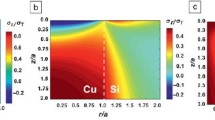Abstract
Recent development in heterogeneous integration for high-performance chips (HPC) demands higher power, which induces a higher level of current density per through-silicon via (TSV) and redistribution layer (RDL) interconnects. Change in electrical and thermomechanical properties during long-term current stressing can result in negative impact on signal integrity and reliability of the device. In this study, test samples of Si interposers containing TSVs with a multilayered RDL structure at the top were tested under current densities ranging from 1 × 105 A/cm2 to 2.5 × 105 A/cm2 at 200°C in vacuum. Microstructural changes were observed in the current-carrying TSVs, and the circuit resistance increased sharply during the test. This increase was associated with several damage modes, including migration of Sn and Ag from solder, and Ni from under-bump metallization, driven by electromigration, leading to alloying and formation of reaction products. A volume increase associated with phase transformations and electromigration-induced void formation defects are identified under highly accelerated testing conditions, which potentially affect the long-term reliability of TSV-containing structures and need to be considered in design and manufacturing protocols for devices and packages.









Similar content being viewed by others
References
Y. Li and D. Goyal eds., 3D Microelectronic Packaging. (Cham: Springer, 2017)., pp.1–15.
L. Meinshausen, M. Liu, I. Dutta, T.K. Lee, and L. Li, Chapter 10: role of diffusional interfacial sliding during interfacial sliding and electromigration-induced motion of copper through silicon via, Semiconductor Devices in Harsh Conditions. ed. K. Weide-Zaage, M. Chrzanowska-Jeske, and K. Iniewski (Boca Raton: Taylor & Francis Group, CRC Press, 2016), pp. 197–224.
P. Kumar, I. Dutta, Z. Huang, and P. Conway, Chapter 3: materials and processing of TSV, 3D Microelectronic Packaging, Vol. 57. ed. Y. Li, and D. Goyal (Cham: Springer, 2017), pp. 47–70.
P. Kumar, I. Dutta, Z. Huang, and P. Conway, Chapter 4: Microstructural and reliability issues of TSV, 3D Microelectronic Packaging, Vol. 57. ed. Y. Li, and D. Goyal (Cham: Springer, 2017), pp. 71–100.
I. Dutta, P. Kumar, and M.S. Bakir, Interface-related reliability challenges in 3-D interconnect systems with through-silicon vias. JOM 63, 70 (2011).
P. Kumar, I. Dutta, and M.S. Bakir, Interfacial effects during thermal cycling of Cu-filled through-silicon vias (TSV). J. Electron. Mater. 41, 322 (2011).
I. De Wolf, K. Croes, O. Varela Pedreira, R. Labie, A. Redolfi, M. Van De Peer, K. Vanstreels, C. Okoro, B. Vandevelde, and E. Beyne, Cu pum** in TSVs: effect of pre-CMP thermal budget. Microelectron. Reliab. 51, 1856 (2011).
Y. Li, K. Croes, N. Nabiollahi, S.V. Huylenbroeck, M. Gonzalez, D. Velenis, H. Bender, A. Jourdain, M. Pantouvaki, M. Stucchi, K. Vanstreels, M.V.D. Peer, J.D. Messemaeker, C. Wu, G. Beyer, I.D. Wolf, and E. Beyne, in 2014 IEEE International Reliability Physics Symposium (2014), p. 3E.1.1–3E.1.5
X. **g, Z. Niu, H. Hao, W. Zhang, and U.H. Lee, in 2015 16th International Conference on Electronic Packaging Technology ICEPT (2015), p. 586–588
M.F. Ashby, A first report on deformation-mechanism maps. Acta Metall. 20, 887 (1972).
R. Raj and M.F. Ashby, On grain boundary sliding and diffusional creep. Metall. Trans. 2, 1113 (1971).
Y. Lin, Y. Hu, C. Tsai, C. Kao, and K. Tu, In situ observation of the void formation-and-propagation mechanism in solder joints under current-stressing. Acta Mater. 53(7), 2029 (2005).
Y. Hu, Y. Lin, C. Kao, and K. Tu, Electromigration failure in flip chip solder joints due to rapid dissolution of copper. J. Mater. Res. 18(11), 2544 (2006).
J.R. Black, Electromigration-a brief survey and some recent results. IEEE Trans. Electron. Dev. 16(4), 338 (1969).
J. Lloyd, Electromigration failure. J. Appl. Phys. 69(11), 7601 (1991).
M.A. Korhonen, P. Borgesen, K.N. Tu, and C.-Y. Li, Stress evolution due to electromigration in confined metal lines. J. Appl. Phys. 73(8), 3790 (1993).
J.J. Clement and C.V. Thompson, Modeling electromigration-induced stress evolution in confined metal lines. J. Appl. Phys. 78(2), 900 (1995).
Acknowledgments
The authors thank Dr. Li Li of Cisco, Mr. Luke England of Global Foundries, and Dr. Sukesh Kannan of Global Foundries for their assistance with various aspects of this work. Support from MDA, NSF (DMR-1309843), and the Cisco Research Center are gratefully acknowledged.
Funding
Division of Materials Research (DMR-1309843).
Author information
Authors and Affiliations
Corresponding author
Ethics declarations
Conflict of interest
The authors declare that they have no conflict of interest.
Additional information
Publisher's Note
Springer Nature remains neutral with regard to jurisdictional claims in published maps and institutional affiliations.
Rights and permissions
Springer Nature or its licensor (e.g. a society or other partner) holds exclusive rights to this article under a publishing agreement with the author(s) or other rightsholder(s); author self-archiving of the accepted manuscript version of this article is solely governed by the terms of such publishing agreement and applicable law.
About this article
Cite this article
Lee, Tk., Yang, H. & Dutta, I. Damage Mechanisms in Through-Silicon Vias Due to Thermal Exposure and Electromigration. J. Electron. Mater. 53, 1214–1222 (2024). https://doi.org/10.1007/s11664-023-10845-5
Received:
Accepted:
Published:
Issue Date:
DOI: https://doi.org/10.1007/s11664-023-10845-5




